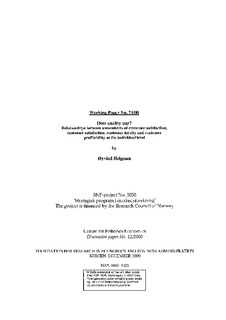| dc.description.abstract | Superior quality is supposed to be positively related to superior business performances. This conception forms the cornerstone of Total Quality Management (TQM). At the individual customer level superior quality is supposed to be positively related to customer satisfaction, the key driver of customer loyalty and customer profitability. According to this way of thinking, the companies that are able to increase the level of satisfaction for their customers can in the long term expect a positive effect with respect to profitability. Nevertheless, only a few studies have examined the relationships between quality and profitability, and hardly any study has dealt with this relationship at the customer level. In this working paper the focus is on the individual customer with respect to the relationships between antecedents of customer satisfaction, customer satisfaction, customer loyalty and customer profitability. The following hypotheses are tested: H1: The higher the perceived quality for the customer tends to be, the higher is his (or her) satisfaction; H2: The more satisfied a customer tends to be, the higher is his loyalty; H3: The more loyal a customer tends to be, the higher customer profitability is obtained; H4: The more satisfied and loyal a customer tends to be, the higher is the obtained customer profitability. As expected, the findings (results) provide strong support for the four hypotheses. However, the relationships between the variables seem to be non-linear (increasingly downward sloping), and only valid beyond certain levels or thresholds. By segmenting the sample of customers into subgroups according to levels of customer satisfaction and customer loyalty, it is found that the customer with satisfaction and loyalty levels above the medians seem to be more preoccupied with quality than the rest of the customers. In addition, the estimates also suggest that these customers are much more profitable than other customers. Taking into consideration the high and conclusive statistical validity of the findings, there appears to be strong support for the “quality paradigm”. Thus, it may be asserted the “quality does pay”. | en |
